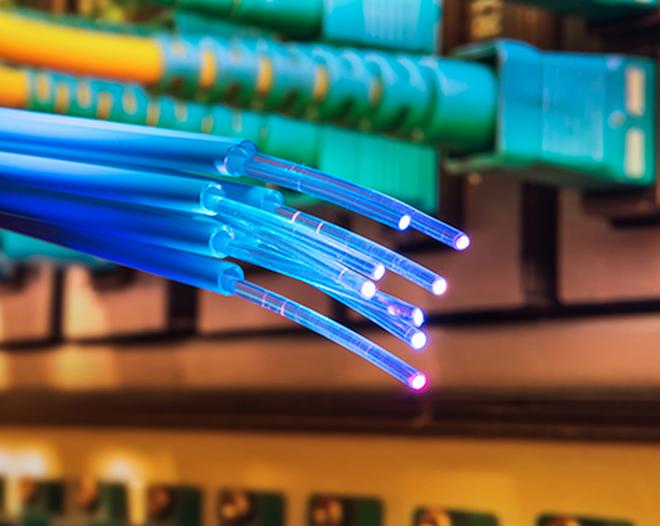During the unprecedented COVID-19 pandemic, the one thing that connected us virtually was the internet. Because of high-speed internet connections, we can now video chat with a friend, pay online, and attend classes or meetings from home. Have you wondered how these connections work?
What is an optical fibre?
Optical fibres are made of thin cylindrical strands of glass. The diameter of a typical fibre is close to the diameter of a human hair. These fibres can carry information, such as text, images, voices, videos, telephone calls, and anything that can be encoded as digital information, across large distances almost at the speed of light.
Receiving text messages and phone calls is a part of our everyday life, and most of us may have taken it for granted. But optical fibres are an essential part of this development in communication.
Ultra-thin fibres seem very fragile. But when manufactured correctly as a long thread surrounded by protectives, they serve the purpose in a durable way. They are strong, light, and flexible, and ideal to be buried underground, drawn underwater, or bent around a spool.

Almost 60 years ago, physicist Charles Kao suggested that glass fibres could be a superior medium for telecommunication, replacing the copper wires of the time. Many people didn’t believe him at first, but his prediction is a reality today. For his ground-breaking achievements concerning fibre optic communication, Dr. Kao received a part of the 2009 Nobel Prize in physics.
How do optical fibres work?
Light is an electromagnetic wave with a spectrum of frequencies. Visible light, X-rays, radio waves, and thermal radiation (heat) all lie on this spectrum. Humans see the world around us via sunlight, but it took us a long time to control and guide light through fibre optic cables – or “light pipes” – to send coded signals.
When a beam of light falls on a glass surface, it passes through partially while the rest is reflected away. When it passes through, its path bends because the refractive index of glass is different from that of air. The refractive index is the property of a medium that determines how fast light can travel in it.
When a beam travels in the reverse direction, i.e. from glass to air, it’s possible that it won’t enter the air. Instead, it will be completely reflected back within the glass. This phenomenon, known as total internal reflection, is the basis of guiding light across long distances without a significant loss of optical power. With proper adjustments, the light can be kept bouncing within the glass with very little escaping outside.
This is how signals encoded as electromagnetic waves can be fed into one end of an optical fibre, and they will reflect and bounce many times between the glass walls as they traverse several kilometres bearing the information in the signals.
A fibre optic communication system consists of three parts. A transmitter encodes information into optical signals (in the form of rapidly blinking light pulses of zeros and ones). An optical fibre carries the signal to its destination. There, a receiver reproduces the information from the encoded signal.
Optical waves allow a high data-transmission rate, up to several terabits per second in a single fibre. Unlike radio or copper-cable-based communication, fibre cables are also insensitive to external perturbations such as lightning and bad weather.
How were fibre optic cables developed?
We have known about the intriguing effects of light in transparent media like water or glass, yet the systematic development of light-guiding can be traced only to the early 19th century. In 1840, Jean-Daniel Colladon at the University of Geneva first demonstrated that light’s propagation can be restricted to a narrow stream of a water jet. Jacques Babinet observed a similar effect in France and extended the idea to bent glass rods.
You may have seen such effects in water fountains lit by colourful beams of light. John Tyndall is known for popularising the idea of Colladon’s light fountains. Following a suggestion by Michael Faraday, he demonstrated the effect in a water jet at the Royal Society in London in 1854. The effect is also visible in plastic-fibre Christmas trees.
We can guide light using total internal reflection with materials that have a higher refractive index than air. As Babinet found, a better choice than water is thin glass rods thanks to their availability, durability, and convenience. Such glass objects found early application in medicine and defence.
In the 1920s, for example, Clarence Hansell and John Logie Baird showed a way to transmit images through glass fibres. Around the 1930s, doctors started using a bundle of thin fibres to inspect patients’ internal organs and to illuminate teeth during surgical procedures.
Early optical fibres were prone to damage and leaky, and weren’t suitable for long-distance transmission of light. In 1954, fibre development made a significant leap forward. Harold Hopkins and Narinder Singh Kapany at Imperial College London transmitted images using a 75-cm-long bundle of more than 10,000 optical fibres. Kapany was an Indian American physicist and a pioneer in the field.
Two years later, Lawrence E. Curtiss at the University of Michigan developed the first glass-clad fibres. His idea to coat the bare glass fibres with a cladding material with a low refractive index paved the way for long-distance data transmission. In the same year, Kapany coined the term ‘fibre optics’.
In 1960, Theodore Maiman built the first laser – an excellent optical source – which further boosted research in optical communication. The development of lasers working at room temperature made it possible to code any information digitally into optical signals. However, sending such light signals across long distances was still a big challenge. Even the best optical fibres available at the time lost 99% of their power after only a few meters.

In 1966, Kao and his colleagues found that the signals were attenuated due to impurities in the glass rather than the light being scattered. He suggested melting high-purity fused silica at high temperatures and producing thin fibre threads from that. This way, the decay of light signals inside glass fibres could be reduced below 20 decibels per kilometre (dB/km) – meaning 1% of the signal could still be detected after a kilometre.
In 1971, the American glass-making company Corning Glass Works achieved this value in a finished cable.
Nowadays, glass fibres are manufactured using the fibre-drawing technique. First, a thick glass rod, called preform, of high purity and an engineered refractive index profile is prepared using chemical vapour decomposition. The preform is heated to about 1,600 degrees C until it melts and is then drawn into a thin, long fibre. The drawing process reduces the fibre’s diameter while maintaining its length. The drawn fibre is coated with a protective layer to enhance strength and durability.
In India, the Fibre Optics Laboratory at the Central Glass and Ceramic Research Institute, Kolkata, has a facility to manufacture high-quality silica-based optical fibres. Today’s optical fibres have a typical loss of less than 0.2 dB/km.
What is the future of fibre optic cables?
Fibre optics technology has since been widely used in telecommunication, medical science, laser technology, and sensing.
With a goal to securing communication and promoting quantum science, the Government of India announced a national mission in the Union Budget of 2020. The proposed budget for this ‘National Mission on Quantum Technologies and Applications’ is Rs 8,000 crore over a period of five years.
The possibilities of fibre optic networks are growing at an accelerated rate, reaching all the way into our homes. Along with quantum optics, fibre optic communication stands on the cusp of a new era.
Gayathry R. and Sebabrata Mukherjee are at the Department of Physics, Indian Institute of Science, Bengaluru.







